Category: locative mobile media
This is a new post about modernity.
Here is the text about the modern world.
Space Elevators may well be a possibility by the year 3000

Moholy Nagy Mini Opera at Other Cinema on 12/11/2021
We staged “Light Space Time & Motion” on 12/11/2021
Moholy Nagy – Light Space Time and Motion
A audiovisual musical journey into the light sculptures of Moholy Nagy
featuring 3D anaglyph projections of the *Light Space Modulator* as well as Moholy Nagy’s own films and the special effects work he built for Alexander Korda’s 1936 Science Fiction classic based on H.G. Wells “Things to Come”.
John Smalley will perform as Moholy Nagy, Molly Hankwitz maker of special stage props and art director.
Music and projection film edited by David Cox.
*Song “Light Space Time and Motion” lyrics by John Smalley, music by David Cox
All Music Tracks by David Cox
Intro
Moholy
Lines and Circles
Tango
ABC of Sound
Light Space Modulator
*Light Space Time and Motion
june research
9th Conference on Computation, Communication, Aesthetics & X 12 – 16 July Online
xCoAx is an exploration of the intersection where computational tools and media meet art and culture, in the form of a multi-disciplinary enquiry on aesthetics, computation, communication and the elusive X factor that connects them all.
The focus of xCoAx is on the unpredictable overlaps between the freedom of creativity and the rules of algorithms, between human nature and machine technology, with the aim to evolve towards new directions in aesthetics.
xCoAx has been an occasion for international audiences to meet and exchange ideas, in search for interdisciplinary synergies among computer scientists, artists, media practitioners, and theoreticians at the thresholds between digital arts and culture. Starting in 2013 in Bergamo, xCoAx has so far taken place in:
Bodies Online – Magdalena Festival is a women in theater festival, Suzon Fuks turned me onto it as she has performed several times. Just caught the end this time around, but want to write more about it for next iteration.
061821_counterculture publication
Article on the countercultural newspaper, The East Village Other to which many luminaries contributed! sent to Craig for his approval. smile.
062021_global_land_commons
native-land.ca – downloadable app and online map of indigenous territories, treaties and languages
The Ultra Tapes – Alan Turing at Other Cinema!
012121_Two
From penned diary entry…hence the date:
January 19th – Eve of Joe Biden’s Inauguration and not better time to write than now…Apprehension, delight, fear, anger, intelligent remorse.
January 21st – Do not know Tony Longson’s work, but as a member of the several network lists, it is clear that due to Covid 19 and other ailments…computer scientists, theorists, computer artists, are getting on and dying out…a whole generation of Web 1.0 users, who made enormous contributions in the very early stages of computer art, are leaving us.
011721_Making Sense
“The Q Anon Shaman: The Return of the Mythic” on Rebelwisdom on YouTube, is a discussion about the gregarious man in the Viking hat who helped storm the capital. Speakers, including Erik Davis, discussed the Q Shaman primarily as a likely social phenomenon of conspiracy thinking, which apparently requires a visual culture to really grow in power, hence badges, flags, costumes, language, acronyms. This form of communication is similar to branding/advertising spin which gains momentum through “identification” with the brand. Wikipedia describes Q Anon (c.2017) as ‘a disproven and discredited far-right conspiracy theory alleging that a cabal of Satan-worshipping cannibalistic pedophiles is running a global child sex-trafficking ring and plotting against U.S. president Donald Trump, who is fighting the cabal. U.S. prosecutors have called it “a group commonly referred to as a cult”. Cults develop through the ability to create feelings and sense of belonging. They have identifying markers, signs, clothing, agreement on their ideology, and members. Mobs also form out of immediate need for attention and the power of “unity” and “identification.”
The era of Trump’s lies and his and his Administration’s quest for power has been the dominant ideological position for 4 years, plenty of time to go from Pizzagate (2016) to QAnon (2021); for followings and “followers” to flock to their screens to see what else has been posted in a disturbingly accelerated pace of development. The sense-making apparatus of civil discourse is inherently progressive and productive because it reveres the exchange of differing ideas and opinion over individual authority. The disillusioned and disingenous empowered populus enerate new “forms” of sense not based in fact or reality and believe their own ideology because it is “right” cannot see their way out of the bottle. Trump has fueled the lean, illogical, ill-informed and ignorant formation of ideas. Social media accelerated the pace of his poisonous “reach” and helped the lies (and his entranced followers) to gain unusually threatening momentum.
The QShaman was a centrally-poised figure in media from the Capitol. Colorful, humorous, raving on and seemingly in control, he acted out a fantasy of control, for what spectator?
City Centered Festival of Locative Media 2010
https://www.flickr.com/photos/gaffta/sets/72157625040877845/with/5082553310/
20 and 21_Jeremy Hight: One-man Literary Artist and Theorist
SEMINAL_TEXTS presents Jeremy Hight: One-man Literary Artist & Theorist
An interview with Jeremy Hight by Molly Hankwitz
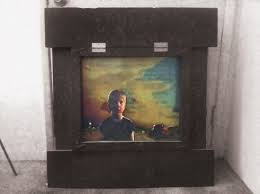
From Hight’s MFA thesis at Cal Arts (never again shown and later destroyed) An interactive work but made only of wood, cheap hinges, and a hidden motor.Text moved when the image was opened in the main gallery, but was impossible to fully read and when it was stopped the next person only saw what was left after the first viewing.
Jeremy Hight is a writer and a theorist. He has been best recognized, perhaps, for his essay, “Narrative Archeologies”, which has been credited as one of four primary texts on ‘spatial narrative’ a feature of locative media, or the practice of place-based art and communications tied to a specific place. Since that essay, Hight been working tirelessly with new media art in literary and theoretical ways, writing for numerous journals and publications, curating with the International Society of Electronic Artists, and concerning himself with how narrative structure works within current technologies and memory as a novelist.
——–
In this long-awaited exchange, I asked Jeremy about the locative work he did on the collaborative project 34 North 118 West as an inspiration or catalyst for his novels:
That first (or one of the first) locative narrative works was made mostly because the technology could let places and history “speak”and potentially “skin” the world with stories; things not possible on paper. I literally almost got run over by a car when the idea hit me while crossing the street — theory feeds the writing and vice versa for me— and theory can be so beautiful in ideas and in exploration in the way of narratology and poetics! Also, my mind processes in pictures and leaps. Some lean toward theory and others to a story or sometimes both.
And about starting out writing novels and pursuing writing…?
I wrote and completed three novels years ago but felt each had huge flaws. I did a wild cleanse and tossed them out (3 hefty bags of paper). I knew I must always keep learning, pushing, working toward new aspects of voice and craft and the cleanse ended up really helping this process. Soon after I had an epiphany while heading to work on a summer morning as the sun was just breaching the horizon. My wife, also an amazing writer), put on Chopin instead of our usual oldies or a podcast and all became light and form, shades of color, a quiet loudness of lines and gradations. It was stunning. I sensed then something elemental and profound in paring things down, implying metaphor, seeing subtle repetitions…
As an odd, young boy I was in love with science, history, writing and word origins (etymology) equally. I sensed that they also all cross-pollinated each other and at times that borders of naming of forms and fields were problematic, limiting and even absurd. As a pimply teen I did things I just told no one about as I was too scared to seem weird. I wrote a unified field theory at 14 that was not terrible, I developed an immersive interactive intuitive weather data analysis tool that narrativized data sites “live” as a simulation at 12; obsessively studied game theory, chaos theory and quantum mechanics in high school. I also began to struggle with math in its mid-ground innards. The steps were hard for me (I see now I have dysfraxia and numbers move around ). The dream of a Phd in meteorology was fading fast. I still loved language, though, and the concepts and beauty of weather and data and I began falling in love with conceptual art.
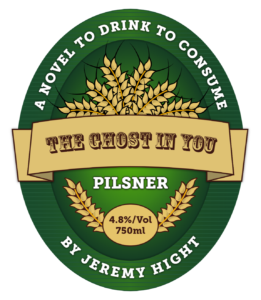
You’ve written this book “The Ghost in You”. Tell me about how the publication came about…
The publisher runs a radio show and has interviewed me before about my more conceptual and new media work as well as short stories. He is a conceptual artist himself and sound artist. Life is funny. I was shopping for publishers for my novel and he said, ‘Hey, what if we make it a conceptual work together?”The book is printed as a zine format intentionally, but with double cover and he selected symbolic images and new line breaks before typesetting so it is the death of the author and a work of text and image and a larger concept. The run is only a hundred in print and each is hand numbered like prints of a painting would be. After we sell out (soon) it will only be available as a digital download and the “book” as object will be a ghost. I will be making it over as dada-esque objects for sale, too, goofy votive candles, jellies to spread on toast (or not), and a beer brewed based on the balance of elements in the prose (an idea I first had years ago… relating a digital image or text as a balance of “flavors” in something tangible like a soda.
My other book available on Amazon is called “What Remains” and it was published by a semiotician and digital artist named Talan Memmott. It was a conceptual work that took sci fi films like Jurassic Park and took out all sci fi and text and I wrote new classic literary prose from the skeletal prose and narrative that was to remain. Jurassic Park with no computers or park is a bare-bones tale of faith and mortality. It worked surprisingly well. My first published book was called “I Am the Ghost Here” and was a short story collection that crashed Hitchcock-like suspense with elements pulled only from the dynamics of social media. The ghost is/was both me as author (Roland Barthes again with death of the author) and of self into flesh space and digital space.
Tell me about the ghosts…
The place we live in now has a gentle hungry ghost…Female….I wish I could help her. I really do. But, she exists in a liminal space; perhaps in a house long gone as did the ghosts in my parents’ house growing up (a man always politely floating around looking for his wife and her falling and making a splash for twenty years among other things). Time is not linear and these spirits are self-aware. The man would actually apologize when seen and she has said she is hungry and cold. We both have heard it. In the novel I felt the need to explore narrative as a sort of moebius strip, two characters and stories that overlaid, but never literally crossed. She senses him as a moving of air as he is a spirit while he flies/drifts to help her. At times he can see things mortals simply cannot. There also are subtle similarities between the two. She longs to actually touch objects for a tactile kind of memory trigger; to feel the past and loss while he is tired of absolute freedom and misses the aches and itches of a body and things like job interviews, a shoe untied, the obtuse mundane bondage of existence. William Blake blew me away as a teen because he examined huge dichotomies not in ethics and nature but in poetics and within seemingly something else added. Martin Amis in Time’s Arrow showed by time moving backwards how horrific moments in history can be in their inhumanity and cruelty as almost to do harm to time and space itself. Toni Morrison showed me how so much internal pain could be expressed so powerfully by both metaphors and descriptions; that deeper inference. Such amazing work.
Ghosts come with a litany of clichés. How did you approach this?
I wanted to avoid the minefield of ghost clichés some of which are: how they move, are disconnected, can lead to cheesy messages and even bad love stories so often. The ghosts in some Japanese stories, however, are echoes from the past and can even be moral compasses in the present for those who have strayed from what is moral and kind. Other ghost clichés I worked to avoid included the ideas of the evil ghost, the benevolent ghost, the one dimensional spirit that is a cartoon, the redemptive moral allegory of the ghost having to find their divine purpose and of the ghost being some symbol of modern society. These were on my mind while writing the entire book as pitfalls into which the writing could fall. The ghost in the book is morally ambiguous, thus, at times wishing to be parasitic in a human to “live again” and taste the little things we hate like failures and limitations, the mundanely moral. At other times he is caring , melancholy, and longing for some greater meaning to grasp.
Talk a bit about what drives your creative process or gives it meaning…?
I wrote the book using music as a kind of internal spatial joystick for him (the ghost). Ambient-like Eno when he was to drift across the skies, Chopin and other classical when he needed to move more specifically on the ground and with others alive or also in a liminal space. I tried to keep that first morning I mentioned above close as well, with the sun rising and light and shadow along the forms of nature and city; that deep tide under things simply as they are. Something I see in both main characters and their lives and events they exist in is a kind of combination of solidity and fluidity, sort of like the butter melting on the persistent pancake metaphor.
Memory, it has been argued, is the main body of a life lived and how one sees oneself and their place in this world. The present is but a hectic or dull sliver that only feeds, continually, the past. It is what remains, decays, distorts or is forgotten. Neurological science has found that we must forget or little details will sink cognition into a morass of minutia and detail. There is something so moving in the need to forget and to remember deeply, but incompletely. A beloved book if remembered whole and complete would cool down (like that pancake stack in the opening scene) into something not to return to, into words as driving directions, not poetics and resonance, so we forget parts and remember others and return again as a different person to read the work as our life experience. Current world and tastes and desires have changed as they always do, yet a spark forms once again, and a conduit and circuit flows once again.
What are you working on now?
My theory has come to show itself in new media art, electronic literature, glitch art, sound art, theory texts and concepts within stories and what a book can be. Now I am researching artificial intelligence and have developed methodologies to pull new chapters from old novels by extending algorithms and the unfinished equations within a narrative of interactions of variables and self-aware prose that changes with each reader and “reads” by parsing text from the internet. The funny thing about academic writing is I have published mostly book chapters (semiotics, art theory, aesthetics, art history, pedagogy, semantics, poetics and digital art methodologies) but outside of classrooms I wonder who reads them at all. They perhaps are the true ghosts.
I’d like to read your pedagogy. We need strong ideas in pedagogy today for the kinds of students we have and to decolonize academia – with the #BIPOC, #LGBTQ movements, women’s movement.
Thank you for taking time to give us your provocative insights about the work.
_____
Literary art projects by Jeremy Hight:
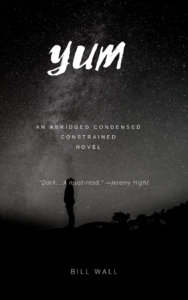
Ukrainian writer’s “novel” – a pdf digital work with isbn (just the word “yum.”
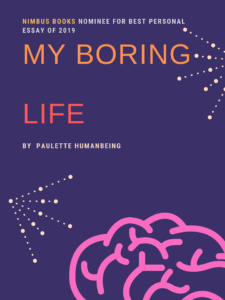
A few paragraphs by conceptual artist published as a digital book
and awarded imaginary award.
These fake book covers are from “Nimbus”, an absurd publishing house
within an imagined, smelly room behind the timeline on Facebook.
It is a conceptual folly. Designed by Jeremy Hight and shown in galleries and online exhibitions.
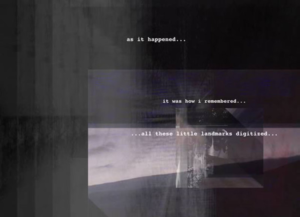
Still from the collaborative work “Carrizo Parkfield Diaries” now in the permanent digital collection of the Whitney Museum of American Art.
Hight’s prose poems of ‘memory’ and ‘trauma’ were correlated to data from earthquake sensors in the San Andreas fault.
‘The work was me beginning to look at the notions of text and image and form and ephemerality be it in digital art or other forms.’ – Jeremy Hight.
Links to get Jeremy Hight’s new book:
The Ghost in You
https://www.scribd.com/document/253695273/i-am-the-ghost-here-by-jeremy-hight
What Remains
https://www.barnesandnoble.com/w/what-remains-jeremy-hight/1125549006